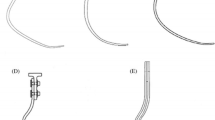Abstract
The need for artificial limbs or prostheses has been on the rise due to army personnel being injured in recent conflicts, an increase in the numbers of senior citizens, and road accidents. Fabrication of artificial limbs is a challenge since the shape and size of each prosthesis is different, and they have complex geometries. Conventional manufacturing processes are not economical when dealing with a customizable prosthesis, so the newer technology of additive manufacturing is considered in this study. To fully exploit the advantages of this process, topology optimization was implemented on the geometry. The subject’s leg was scanned, and the obtained geometry was simplified using ANSYS’ SpaceClaim. The consequent optimization was done in solidThinking Inspire. Two case studies were considered, wherein the geometry was first optimized through conventional topology, and then the resultant geometry was further developed with a lattice. These cases were compared regarding the strength–weight ratio. Fatigue analysis was carried out for both scenarios. Also, the exoskeletal shape of the tibial region of the leg was maintained. Finally, the strength of the resultant prosthesis was validated through a compressive testing experiment.




















Similar content being viewed by others
References
Siva Rama Krishna, L., Mahesh, N., Sateesh, N.: Topology optimization using solid isotropic material with penalization technique for additive manufacturing. Mater. Today Proc. 4(2), 1414–1422 (2017)
Rozvany, G.I.N.: A critical review of established methods of structural topology optimization. Struct. Multidiscipl. Optim. 37, 217–237 (2009)
Sundararajan, V.G.: Topology optimization for additive manufacturing of customized meso-structures using homogenization and parametric smoothing functions, p. 174 (2010)
solidThinking Inspire: https://solidthinking.com/. Accessed 4 Apr 2018
Dong, G., Wijaya, G., Tang, Y., Zhao, Y.F.: Optimizing process parameters of fused deposition modeling by Taguchi method for the fabrication of lattice structures. Addit. Manuf. 19, 62–72 (2018)
Tang, Y., Zhao Y.F.: Lattice-skin structures design with orientation optimization. In: Solid Freeform Fabrication Symposium, pp. 1378–1393 (2015)
Maskery, I. et al.: The BCC unit cell for latticed SLM parts ; mechanical properties as a function of cell size. In: Solid Freeform Fabrication Symposium, pp. 688–701 (2014)
Panesar, A., Abdi, M., Hickman, D., Ashcroft, I.: Strategies for functionally graded lattice structures derived using topology optimisation for additive manufacturing. Addit. Manuf. 19, 81–94 (2018)
Robbins, J., Owen, S.J., Clark, B.W., Voth, T.E.: An efficient and scalable approach for generating topologically optimized cellular structures for additive manufacturing. Addit. Manuf. 12, 296–304 (2016)
Walton, D., Moztarzadeh, H.: Design and development of an additive manufactured component by topology optimisation. Procedia CIRP 60, 205–210 (2017)
Larsson, R.: Methodology for topology and shape optimization: application to a rear lower control arm (2016)
Clausen, A., Aage, N., Sigmund, O.: Exploiting additive manufacturing infill in topology optimization for improved buckling load. Engineering 2(2), 250–257 (2016)
Primo, T., Calabrese, M., Del Prete, A., Anglani, A.: Additive manufacturing integration with topology optimization methodology for innovative product design. Int. J. Adv. Manuf. Technol. 93(1–4), 467–479 (2017)
Chen, R.K., Jin, Y., Wensman, J., Shih, A.: Additive manufacturing of custom orthoses and prostheses-a review. Addit. Manuf. 12, 77–89 (2016)
Canfit 3D CAD Prosthetic and Orthotic design software: http://vorum.com/cad-cam-prosthetic-orthotic/canfit-design-software/. Accessed 20 Mar 2018
ANSYS SpaceClaim: https://www.ansys.com/products/3d-design/ansys-spaceclaim. Accessed 20 Jan 2018
Iso: ISO 10328: Prosthetics—Structural testing of lower- limb prostheses—Requirements and test methods, vol. 3 (2006)
The world’s fattest countries: how do you compare? – Telegraph: https://www.telegraph.co.uk/news/earth/earthnews/9345086/The-worlds-fattest-countries-how-do-you-compare.html. Accessed 4 Feb 2018
Shigley, R.G., Mischke, J.E., Budynas, C.R.: Mechanical Engineering Design, 7th edn, p. 163. McGraw-Hill, New York (2004)
Sigmund, O., Petersson, J.: Numerical instabilities in topology optimization: a survey on procedures dealing with checkerboards, mesh-dependencies and local minima. Struct. Optim. 16(1), 68–75 (1998)
Radisch, F.: 3D elements in solidThinking Inspire. https://forum.solidthinking.com/index.php?/topic/1612-link-between-the-analyse-and-the-optimization/&tab=comments#comment-3262. Accessed 25 July 2018
Pruitt, L.: Fatigue testing and behavior of plastics. Mech. Test. Eval. 8(c), 758–767 (2000)
Cain, J.: Stepping up to health: using a pedometer for amputee fitness. inMotion 17(4), 40–42 ( 2007)
Roche, J.J.: The Mathematics of Measurement: A Critical History. Athlone Press, London (1998)
Zhang, P., Liu, J., To, A.C.: Role of anisotropic properties on topology optimization of additive manufactured load bearing structures. Scr. Mater. 135, 148–152 (2017)
Acknowledgements
The authors would like to express gratitude to Mr. Fred Rayner of Applied Biomechanics for sharing his knowledge regarding prosthetics, and for providing the required 3D scanning equipment. The authors would also like to thank Mr. Felix Radisch of solidThinking Inspire for sharing meticulous details of the software employed. The authors would also like to thank the financial support from NSERC and OCE.
Author information
Authors and Affiliations
Corresponding author
Additional information
Publisher's Note
Springer Nature remains neutral with regard to jurisdictional claims in published maps and institutional affiliations.
Rights and permissions
About this article
Cite this article
Jansari, T., Deiab, I. Comparative study of a topologically optimized lower limb prosthesis. Int J Interact Des Manuf 13, 645–657 (2019). https://doi.org/10.1007/s12008-019-00540-3
Received:
Accepted:
Published:
Issue Date:
DOI: https://doi.org/10.1007/s12008-019-00540-3




